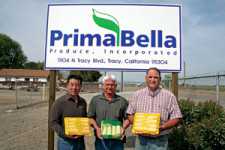Prima Bella’s Unique Sales Approach

If you ask John Bacchetti about his sweet corn growing operation, he’ll tell you that wouldn’t be a logical place to start. It makes more sense to start at the beginning, and that means with marketing, not growing. He has a marketing plan in place for every crop he grows each year well before the season starts. “If you don’t have a home for it, you shouldn’t grow it,” he says. “We start the marketing process way before we start the planting process.”
In fact, that way of doing business extends well beyond annual business planning. The story of his family’s operation, Del Terra Farms of Tracy, CA, all begins with marketing. And while it is a somewhat complicated story because of the family members involved and the way the various businesses are intertwined, it all comes back to that tried and true concept of business: Find a need and fill it.
In 1996, John Bacchetti’s cousin, Mark Bacchetti, founded Marca Bella Farms. Together Marca Bella Farms and Bert Bacchetti Farms (Mark’s father) built an asparagus packingshed in Tracy, which is located about an hour east of San Francisco. The asparagus shed was only used for about three months a year, however, and when the area’s asparagus industry started going south (literally, to South America), Mark began thinking about how he could best put the 23,000-square-foot shed to use. He decided on packing sweet corn, which is harvested locally from mid-June through late October. And in 1999, Prima Bella Produce, Inc., which now packs corn year-round grown as far south as Mexico, was born.
Prepare For Takeoff
Today, Mark, John, and John’s brother-in-law Jim Thoming are partners in Del Terra Farms, a diversified 4,500-acre operation which grows such vegetables as cannery tomatoes, asparagus, and lima beans as well as 1,300 acres of sweet corn. All the corn is processed by Prima Bella, which is solely owned by Mark Bacchetti. But they didn’t start off nearly that big. When they began in the late 1990s they farmed just 16 acres of sweet corn, total. “Back in 1999, we started out hauling boxes in a pick-up truck to Safeway,” says John. “Then that commodity (packaged sweet corn) just took off.”
Today they grow just enough corn to keep the processing plant humming away in the summer. To keep the plant — which is the largest of its kind west of the Mississippi River — supplied during the rest of the year, they contract with about 10 growers from as far away as Mexico, and, to a far lesser extent, Florida. Nearly all the growing takes place in the West. The key to their success is that each package of Glori Ann sweet corn — Gloria Ann is Mark Bacchetti’s mother’s name — is uniform, says Prima Bella General Manager Paul Bogetti. “The whole plan is to make sure that when the consumer picks up a package it tastes the same no matter what time of year,” he says.
To that end, they supply the growers they contract with a list of about a dozen varieties they can grow. The growers aren’t always particularly pleased to have the varieties dictated to them, but it’s necessary to achieve uniformity, says Bogetti. John Bacchetti smiles and nods at the plant manager’s comment. “That even holds true,” he says with a laugh, “with the farmers who are related to the guys who own the shed.”
We’re All Farmers
It helps, though, that all involved in the operation are either active in farming or have farmed in the past. “We understand what they want in terms of yield,” says Bogetti. “You can find the best tasting corn out there, but if it doesn’t yield it’s not going to work.”
They are always on the hunt for better varieties. Marc Mizuno, who heads up procurement for Prima Bella, is constantly working with seed company breeders. They plant hundreds of varieties each year, and from those the breeders will select the top candidates. Prima Bella then winnows down those candidates, working with their growers who allow them to plant seed variety trials in each of their respective growing areas to come up with a final list of acceptable varieties.
Prima Bella also works with growers to maintain food safety. To ensure that they can trace back exactly where a given lot of corn has been picked, all boxes or RPCs are put on pallets and then tagged with a harvest date and location. “We can tell right down to the block of a given field where it came from,” says Mizuno.
Fresh, Never Frozen
Prima Bella further works with growers to make sure the corn is properly packed before being shipped to the processing facility. Because it has such a large core that retains heat, corn is difficult to cool, and immediate cooling is critical to freshness. So most of the corn is cooled immediately after picking through an ice injection process. “It’s like a clamshell around the container,” says Mizuno. “A slush of ice is pumped in to reduce the temperature of the corn.”
At the plant, the corn is trimmed, cleaned, and sorted, all by hand. In fact, all processing except for cutting and wrapping, from picking to when the corn is loaded onto trucks to leave the plant, is done by hand. “If you have just one broken kernel,” explains Bacchetti, “it lowers the shelflife.”
And a long shelflife is extremely important to the mega-stores and large grocery chains throughout the Western U.S. that sell Glori Ann corn. Also, it’s critical to the success of Prima Bella’s next venture, to supply cobs and cob-ettes for foodservice. Currently, that’s largely a frozen business, but Prima Bella doesn’t deal in frozen corn, and they think diners will appreciate that. “We want to put fresh corn into restaurants,” says Bogetti.









